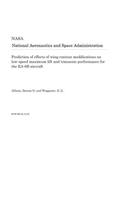
Prediction of Effects of Wing Contour Modifications on Low-Speed Maximum Lift and Transonic Performance for the Ea-6b Aircraft
Series:
Computational predictions of the effects of wing contour modifications on maximum lift and transonic performance were made and verified against low speed and transonic wind tunnel data. This effort was part of a program to improve the maneuvering capability of the EA-6B electronics countermeasures aircraft, which evolved from the A-6 attack aircraft. The predictions were based on results from thre
NaN
VOLUME
English
Paperback

Computational predictions of the effects of wing contour modifications on maximum lift and transonic performance were made and verified against low speed and transonic wind tunnel data. This effort was part of a program to improve the maneuvering capability of the EA-6B electronics countermeasures aircraft, which evolved from the A-6 attack aircraft. The predictions were based on results from three computer codes which all include viscous effects: MCARF, a 2-D subsonic panel code; TAWFIVE, a transonic full potential code; and WBPPW, a transonic small disturbance potential flow code. The modifications were previously designed with the aid of these and other codes. The wing modifications consists of contour changes to the leading edge slats and trailing edge flaps and were designed for increased maximum lift with minimum effect on transonic performance. The prediction of the effects of the modifications are presented, with emphasis on verification through comparisons with wind tunnel data from the National Transonic Facility. Attention is focused on increments in low speed maximum lift and increments in transonic lift, pitching moment, and drag resulting from the contour modifications. Allison, Dennis O. and Waggoner, E. G. Langley Research Center RTOP 505-61-21-03...
Price Comparison [India]
In This Series
Bestseller Manga
Trending NEWS




















